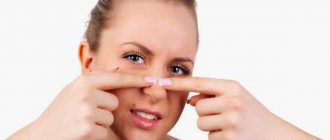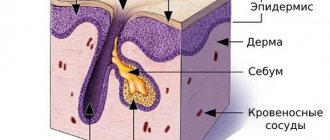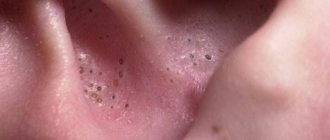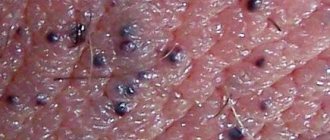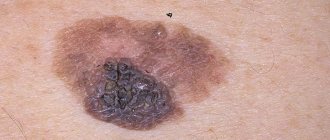The most popular facial cleansing is manual. It is not recommended to do it at home on your own, but many still neglect this rule. What is manual cleaning? Before starting, the skin is thoroughly steamed so that the pores open and are easily exposed. After this, the cosmetologist manually squeezes out the blackheads, thereby cleansing the skin. Next, the skin is disinfected and a mask is applied to it, which will help tighten the pores. It is worth noting that this procedure is effective, but very painful.
Mechanical cleaning is very similar to manual cleaning. Immediately before the procedure, the specialist applies a special warming mask to the skin. Pores are cleaned using a special spoon. The duration of the procedure is approximately 1 hour.
You can get rid of old skin particles using chemical peeling. A solution of special acids will be applied to your face, after which your skin can be compared to the skin of a baby. It is noteworthy that this type of peeling is available to many, because its prices are affordable.
If you are the “lucky” owner of oily skin, then ultrasonic facial cleansing is ideal for you. The skin is cleansed using special sound vibrations. The result, which will undoubtedly please you, will last for a long time. By the way, if you have any skin diseases, then you cannot use this method.
Any salon facial cleansing should be done before the weekend, since after it you shouldn’t apply makeup for a couple of days, and you will really want to do this, because your facial skin will be unnaturally reddish.
How to cleanse your face at home?
The easiest and cheapest way is cosmetic clay, which can be bought at any pharmacy. For oily skin, choose green, white and blue clay. If you have dry skin, then you need to buy red clay. Black clay is suitable for any skin type. This product must be diluted with water (preferably mineral water). The consistency of your mask should resemble a thin porridge. Keep this mask for 15 minutes, then rinse with warm water and apply moisturizer. Remember that no powder or foundation can give you the same effect as regular facial cleansing.
Among common cosmetic procedures, one of the leading places is occupied by cleansing the skin of excess impurities and dead cells. Facial cleansing, the prices of which are kept within moderate limits, is performed for hygienic purposes, in addition, it stimulates metabolic processes, nutrition and blood supply in the upper layers of the skin. The procedure is recommended for both men and women, starting from the age of puberty.
Facial cleansing: different types
- combined
- mechanical;
- ultrasonic;
The type is selected after consultation with a doctor, during which the specialist, based on the characteristics of the skin and individual indications, chooses the most effective method of treatment. Ultrasonic facial cleansing is recognized as the most effective.
Indications for ultrasonic facial cleansing:
- sebaceous glands with enlarged pores;
- comedones;
- a large number of acne in the healing stage;
- combination and aging skin;
- lack of skin tone.
Contraindications:
- eczema;
- herpes;
- severe hypertension;
- epilepsy;
- diabetes;
- mental disorders.
Why do you need to cleanse your face?
The skin is the largest organ of the human body, which ensures its respiration, metabolic processes, and also protects against the penetration of infections. However, people's facial skin varies, and depending on its oil content, both the sebaceous and sweat glands, which are abundantly located in the thickness of the layers of the skin, function differently.
Ultrasonic cleaning
Description of the procedure
To carry out ultrasonic cleaning, a special ultrasonic device is used. During this procedure, the face is exposed to ultrashort waves that penetrate deeply into the skin and provide micromassage to the tissues. Indications for ultrasonic cleaning are the same cases of clogged pores and non-inflamed acne.
Ultrasonic cleaning does not harm the skin at all. The influence of ultrasound not only deeply cleanses the skin of toxins, impurities, sebum and blockages of the sebaceous glands, but also during ultrasonic facial cleansing, micromassage of the skin is performed and smoothing out fine wrinkles.
Ultrasonic cleaning is good because it is non-traumatic and absolutely painless, leaving no marks or redness.
Preparation
Before ultrasonic cleaning, the skin must be cleaned of makeup, dust, and dirt using regular cleansers depending on the skin type. Then a special tonic or gel is applied to the skin, which, when exposed to ultrasound, will cause old cells to peel off.
Carrying out the procedure
When carrying out ultrasonic cleaning, the cosmetologist moves the tip of the ultrasonic device over the face. At the same time, the entire upper dead layer of skin is exfoliated, impurities, makeup residues, and waste products of the glands come out of the pores to the surface. All this dirt is immediately removed by a cosmetologist. As a result, the skin looks younger and fresher, because ultrasonic cleansing of the skin also causes superficial peeling.
With ultrasonic facial cleansing, the skin not only becomes fresher, but also becomes healthier. After cleansing, pores are reduced, scars heal faster and skin irritation goes away. Skin oiliness is noticeably reduced due to exposure to ultrasound, so those with dry skin should continue to use various moisturizing creams and masks.
The procedure is performed without preliminary steaming of the skin, which is suitable for skin with vascular mesh.
The final stage
If your facial skin has a lot of clogged pores, comedones, etc., then gentle ultrasonic cleansing will not give a 100% result and will have to be supplemented with manual intervention. However, in all other cases, ultrasonic cleaning maintains youthful and toned skin. If mechanical cleaning is carried out after ultrasonic cleaning, then the already described procedures are carried out to soothe the skin. If cleaning is limited to exposure to ultrasound, then after this there is no need to further soothe the skin, however, the renewed cells will gratefully accept a variety of cosmetic care procedures.
At the same time or after ultrasonic cleaning, it is advisable to carry out ultraphonophoresis, that is, the introduction of various nutritional preparations into the skin.
Combined cleaning
In this case, we are talking about a combination of hardware and manual techniques. Most often, combinations of vacuum and mechanical or vacuum and ultrasonic cleaning are used to deep clean clogged pores. A combined approach is usually used for combination or sensitive skin, which allows different areas to be treated more effectively.
Pros:
- the possibility of using different treatment methods for areas with varying degrees of contamination;
- minimal trauma to the skin.
Disadvantage: when using gentle techniques, some areas need to be treated several times.
Peeling
All peeling products can be divided into 3 main groups according to their mechanism of action:
- Mechanical peeling (manual peeling, hardware peeling, micro-polishing);
- Physical peeling (ultrasonic peeling, laser peeling);
- Chemical peeling (based on the use of different substances).
In addition, peeling methods should be distinguished by the degree of “aggression” (depth of penetration into the skin layers):
- exfoliation, i.e. exfoliation of the stratum corneum;
- epidermolysis, i.e. superficial peeling procedure;
- medium peeling
- deep peeling
Superficial peeling
Superficial peeling affects only the upper layer of the epidermis - from horny to granular. It is recommended to prevent skin aging. Superficial peeling evens out the surface of the skin, improves the color and texture of the skin: pores narrow, wrinkles become less noticeable. In this case, only the horny cells of the epidermis are exfoliated. A peeling course consists of 5–7 procedures, the interval between which is a week. The very next day you can use cosmetics. For the procedure, fruit (alpha hydroxy) acids of varying concentrations are used, which depends on the type and condition of the skin (determined by the doctor).
Superficial peeling is the most gentle compared to medium and deep peeling. Its essence is damage, creating a burn surface on the skin. An acid of a certain concentration and strictly in time is applied to cleansed skin with a brush. The deeper the peel, the stronger the acid used and the more difficult the procedure.
Soft: the stratum corneum is destroyed to the granular layer (stratum granulosum). These include: Jessner solution, CO2, dry ice, fruit acids 20-70%, trichloroacetic acid 15%.
Superficial peeling is performed without anesthesia and is accompanied by severe redness of the skin, itching and peeling. Feeling as if someone walked over the face with a pumice stone. In the coming days, the skin begins to peel off and dry crusts appear.
At this time, the skin is treated with special products and wound-healing medications. The success of the procedure largely depends on skin care after the procedure. It is very important not to peel off the crusts and husks until they come off on their own. For a certain period of time, you should not appear in the sun, much less sunbathe, otherwise age spots will appear on your face, which are very difficult to eliminate. The remission period is 2-3 weeks.
Facial cleansing with fruit and other acids is essentially an exfoliation. These procedures are used after mechanical or hardware facial cleansing to smooth out the skin texture and remove dead cells.
If there is acne on the skin (not in the inflammatory phase!), then you can use superficial acid peeling to remove plugs from the pores. Chemical peeling with fruit acids refreshes the skin and cleanses surface impurities, but does not reach deep-lying inflammations.
In these cases, chemical peeling can only be the final stage after mechanical and other cleaning methods. The peeling procedure can be called “aggression for good.” The ability to regenerate is the most important property of the skin, without which it could not act as a barrier between the body and the external environment. The slightest breach in it can become fatal, so the reaction to damage occurs immediately. A signal for restoration work is any traumatic impact: a scratch, abrasion, burn, exfoliation of horny scales, etc.
Fruit peeling is a gentle facial cleansing that gently cleanses the skin of dead cells and toxins. Thanks to a gentle technique, this type of peeling can be used without any age restrictions, which makes it possible to prevent the formation of wrinkles at the very initial stages, improve the functioning of the sebaceous glands, the process of skin regeneration, and also stimulate the synthesis of collagen fibers, which are responsible for the elasticity and smoothness of the skin. Cosmetology specialists recommend fruit peeling for facial skin with signs of photoaging, since this procedure has not only a smoothing, but also a brightening effect. In order for the effectiveness of such peeling to be maximum, it is necessary to follow several simple rules.
The most important thing, of course, is to follow the advice of a cosmetologist who conducts a series of peeling sessions, the number of which can vary from 4 to 10 depending on the method of implementation, the concentration of the active substance and the condition of the skin. And also remember that for 30-40 days after and directly during the procedure, sunbathing is strictly contraindicated, and even better, constantly use sunscreen with a high degree of protection.
It should also be understood that such peeling does not give an immediate effect, and its positive effects appear gradually. That is, every day your facial skin will become younger and healthier. The process of gently cleansing the skin of the face itself is based on the action of AHA acids, which, due to their natural origin, are known in the same way as fruit acids. Although today these substances can also be obtained artificially, which does not make them less effective. The most commonly used are citric, glycolic, lactic, tartaric and malic acids.
Each of them has its own characteristics, but many cosmetologists believe that the best peeling is glycolic. This is explained by the fact that the molecular sizes of this acid are much smaller than others, which guarantees a deeper penetrating effect. Most specialists use a mixture of several acids.
Also, AHA acids, for a more pronounced and lasting effect, are combined with other substances, for example, vitamins A, E, salicylic acid (for deeper cleansing), etc.
The fruit peeling procedure is a seemingly simple process, but it requires specific knowledge, skills and experience. Therefore, it is better to trust its implementation to experienced professionals who have positive recommendations and characteristics.
Black dots on the face: causes
Do you know what such a defect is called from a scientific point of view? In medical circles, clogged pores are called open comedones. Their formation is facilitated by a number of negative factors, which can be divided into external and internal. External causes of clogged pores include:
- Negative environmental impact. By protecting the dermis from the harmful effects of external factors, the body stimulates the production of sebum, which in turn can lead to clogged pores48.
- Incorrect care. The use of cosmetics that are not suitable for a specific skin type, poor-quality removal of cosmetics, and irregular peeling lead to the appearance of comedones on the face48.
To understand why blackheads appear on the face, you need to consider internal factors49,80:
- Hormonal imbalance. Age-related changes and changes in hormonal levels in women negatively affect the condition of the skin.
- Avitaminosis. A lack of vitamins or microelements immediately affects the face, so at any time of the year you need to monitor the vitamin composition of your diet.
- Unbalanced diet. Sometimes the appearance of blackheads is associated with an excess of simple carbohydrates in the diet.
- Genetic predisposition. The appearance of open comedones is sometimes associated with heredity. In this case, it is not easy to determine how to cure the pathology, because a factor such as heredity cannot be eliminated.
- Stress. Under stress, the body increases the secretion of sebum, which, if not properly cared for, leads to clogged pores. This is why, after stress, you may notice that blackheads and other forms of acne appear on your face.
- Bad habits. Smoking, drinking alcohol and other bad habits negatively affect the general condition of the body, which leads to deterioration of the skin.
One of the necessary facial care procedures is cleansing. It allows you to maintain healthy skin, regardless of age. There are several cleaning options, each with advantages and disadvantages. Only a qualified cosmetologist or dermatologist can advise you to select care methods, as well as determine how to treat comedones.
Summer peelings (all-season)
Summer peels are a very demanding procedure for post-peeling care. Because in summer the sun is very active. Accordingly, most peels cannot be done in the summer, while others can be done under certain conditions, and only with proper post-peeling care.
The main recommendation when carrying out peelings is to avoid periods of increased solar activity, because... the protective layer of the skin becomes thinner. Which leads to increased sensitivity to ultraviolet radiation.
Also, when the upper layers of facial skin are damaged, cells producing the melanin pigment are activated, and this leads to the risk of pigmentation disorders.
For people with a seborrheic constitution, with thick, porous and oily skin, regular peeling is recommended, even in summer. This helps them maintain healthy looking skin. And for this, the most superficial peeling (at the level of the stratum corneum) is sufficient, without affecting the skin barrier.
In these cases, preparations with AHA acids in low concentrations, salicylic, lactic, almond or ferulic peels are sufficient. There is also a need to prescribe deeper peels. These are chrono- and photoaging, rosacea, acne and post-acne. And for many people, summer, as the holiday season, is the only opportunity to conduct a peeling course.
Concluding the above, it should be noted that it is very important during the period of peeling in the summer and for 3-4 weeks afterward, you must constantly use sunscreen with a protection factor of at least 30, and in some cases even 50. Do not sunbathe during periods of active sun, do not visit the solarium and, under no circumstances, do not get sunburned. Remember that sunscreens wash off with water, even waterproof ones must be reapplied several times a day.
Mechanical (manual) cleaning
The procedure involves removing the stratum corneum of the epidermis, as well as excess sebum from the surface of the skin. Cleaning the pores is done manually, the process is similar to the usual squeezing of pimples. Compliance with antiseptic rules is of particular importance during the procedure.
Pros:
- helps remove rashes;
- deeply cleanses pores.
Minuses:
- high risk of tissue scarring;
- discomfort during the procedure;
- long period of rehabilitation;
- contraindicated in the presence of purulent and inflammatory formations.
Mandelic acid
40% mandelic acid.
The most gentle acid that can be used even by teenagers over 10 years old. It is used for very sensitive skin, can be done in the summer, and also as a preparatory peeling (pre-peeling preparation) for a subsequent course of other acids. This is a specific treatment, indicated for all skin types, also for very sensitive and thin skin, does not create any aesthetic discomfort and gives visible and long-lasting results.
Indications:
- hyperpigmentation
- treatment of mild acne
- comedones
- treatment of rosacea (even acute phases)
- at all stages of demodicosis (as an addition to treatment)
Results:
Immediate improvement:
The skin glows from the inside, becomes polished, and acquires a beautiful color. Can be done before and after tanning in a solarium or in the sun, before applying makeup.
Almond care No. 1 is aimed at structural rejuvenation of the skin. Leads to noticeable improvements in the appearance of the skin. — Improves and makes the tan more even.
- Strengthens the skin's immune system.
- Protects cell DNA.
- Removes the first signs of inflammatory erythema and reduces the effects of free radicals.
Strengthens the skin barrier.
Frequency of the procedure:
1 time per week up to 10 procedures. Alternation with INTERACTIVE CARE is possible.
Almond care No. 2 for facial skin with pigmentation problems: aimed at structural rejuvenation of the skin. Leads to noticeable improvements in the appearance of the skin.
- Strengthens the skin's immune system.
- Protects cell DNA.
- Removes the first signs of inflammatory erythema and reduces the effects of free radicals.
- Strengthens the skin barrier, facial skin becomes less susceptible to aggressive environmental factors.
FREQUENCY: 1 time per week, up to 10 procedures.
Black dots on the face: treatment
Proper skin care and cleaning in a cosmetologist's office are important in the process of getting rid of open comedones, but this is only an auxiliary measure. After some time, the pores will become clogged again. For acne treatment to be effective, it is necessary to influence the pathogenesis of the disease (follicular hyperkeratosis, colonization of propionibacteria, increased sebum production, inflammation)9.
In the treatment of mild to moderate acne, azelaic acid preparations, for example, Azelik®9.5, can be used. The product must be applied twice a day after washing to dry skin5.
*acne shape
Complications arising during the rehabilitation period
Post-inflammatory pigmentation
Uneven pigmentation can occur in response to any deep damage to the skin. Exposure to the sun without sunscreen increases pigmentation.
Exacerbation of acne
Patients with seborrhea (oily skin) or acne may develop rashes 2-4 weeks after the procedure.
Wide pores
Chemical peels can stimulate pore enlargement. This most often occurs in people with thick skin. Enlarged pores appear 3-4 weeks after the procedure, and disappear at 6-10, since by this time new collagen fibers are formed.
Persistent increase in facial skin sensitivity
When performing deep peels on people with thin, dry, sagging skin, sensitivity may increase. This condition can last from several weeks to several months and is accompanied by redness of the skin.
Late complications
- Hypertrophic reactions (uneven thickening of the skin)
- The upper lip, cheeks, and lower eyelids are most susceptible to these complications; this is especially common with deep peels.
- The development of hypopigmentation (areas of skin lacking pigment) depends on the depth of peeling. Most often occurs after phenol and deep TCA peels.
- Patients with thin, sensitive skin are at risk of developing this complication.
It must be said that it is not enough to have the procedure done in a clinic; it is also important to properly care for your facial skin during its recovery period.
Post-peeling care includes the use of cosmetics containing antioxidants and wound-healing components (vitamin A, E, F, panthenol), moisturizers (hyaluronic acid), products that soften and restore the structure of the barrier (lipid) membrane (shea butter, vegetable and mineral oils ). The use of photoprotective products is mandatory. It is necessary to avoid exposure to the sun (solarium, beach tanning). For medium peels, you should initially refrain from visiting the bathhouse or sauna.

